Lauryl Alcohol Ethoxylate
Lauryl Alcohol Ethoxylate Specification
- Shelf Life
- 12 Months
- Usage
- Used as a non-ionic surfactant in: Detergents and dishwash liquids Textile wetting and scouring agents Emulsifiers in cosmetics and agrochemicals Industrial cleaners and degreasers Provides excellent emulsifying, wetting, and foaming properties
- CAS No
- 9002-92-0
- Ingredients
- Lauryl Alcohol
- Solubility
- Soluble in water
- HS Code
- 3824.99.00
- Molecular Formula
- C12H25(OCH2CH2)nOH
- Properties
- Appearance: Clear to slightly hazy liquid or waxy solid (depending on ethoxylation) Odour: Mild, characteristic Solubility: Soluble in water and alcohols pH (1% solution): Neutral to slightly alkaline
- Product Type
- Surfactant
- Appearance
- Liquid
- Application
- Industrial
- Physical Form
- Liquid
- Ph Level
- 7
- Grade
- Industrial Grade
- Storage
- Room Temperature
- Melting Point
- 21 -24 c
- EINECS No
- 500-213-3 ,939-518-5
- Density
- 1.08 Gram per cubic centimeter(g/cm3)
- Poisonous
- NO
- Purity
- 99%
Lauryl Alcohol Ethoxylate Trade Information
- Minimum Order Quantity
- 200 Kilograms
- FOB Port
- JNPT
- Payment Terms
- Cash Advance (CA), Cash in Advance (CID), Letter of Credit at Sight (Sight L/C), Telegraphic Transfer (T/T)
- Supply Ability
- 25000 Kilograms Per Month
- Delivery Time
- 5 Days
- Sample Available
- No
- Sample Policy
- Contact us for information regarding our sample policy
- Packaging Details
- 200 Kgs HDPE Drum
- Main Export Market(s)
- Asia, Australia, Central America, North America, South America, Eastern Europe, Western Europe, Middle East, Africa
- Main Domestic Market
- North India, East India, Gujarat, Karnataka, Jharkhand, Odisha, Punjab, Assam, Delhi, Dadra and Nagar Haveli, Andaman and Nicobar Islands, Arunachal Pradesh, Chhattisgarh, Haryana, Himachal Pradesh, Jammu and Kashmir, Madhya Pradesh, Kerala, Lakshadweep, Mizoram, Meghalaya, Manipur, Andhra Pradesh, Bihar, All India, South India, Central India, West India, Chandigarh, Daman and Diu, Goa, Maharashtra, Nagaland, Rajasthan, Sikkim, Tamil Nadu, Telangana, Tripura, Pondicherry, Uttar Pradesh, Uttarakhand, West Bengal
- Certifications
- ISO 9001
About Lauryl Alcohol Ethoxylate
Lauryl Alcohol Ethoxylate (also known as lauryl ethoxylate or lauryl ether sulfate) is a chemical compound belonging to the class of nonionic surfactants. It is commonly used in various industrial and household applications due to its surfactant properties, which help reduce surface tension and enable the mixing of substances that would otherwise be immiscible, such as oil and water.
Lauryl Alcohol Ethoxylate Properties:
The properties of lauryl alcohol ethoxylate can vary depending on factors such as its ethoxylation level (the number of ethylene oxide units added to the lauryl alcohol molecule), affecting its molecular structure and characteristics. General properties include:
- Physical State: Typically colorless to pale yellow liquids at room temperature; physical state may vary with ethoxylation level.
- Solubility: Generally soluble in water and many organic solvents, making it versatile for aqueous and non-aqueous formulations.
- Surface Activity: Reduces surface tension of liquids, facilitating mixing of immiscible substances like oil and water.
- Foaming: Depending on ethoxylation, can exhibit foaming properties; used in shampoos and detergents to generate stable foam.
- Emulsification: Effective emulsifier aiding formation and stabilization of emulsions (oil-in-water or water-in-oil).
- Temperature Sensitivity: May become cloudy or less soluble in cold water but regain clarity upon warming.
- Hydrophilic-Lipophilic Balance (HLB): HLB value depends on ethoxylation level, making it suitable for various applications from wetting agents to solubilizers.
- Biodegradability: Varies with structure and ethoxylation; some forms are more readily biodegradable, affecting environmental impact.
- pH Sensitivity: Performance influenced by pH; may be less effective in highly acidic or alkaline environments.
- Compatibility: Generally compatible with a wide range of chemicals and ingredients, valuable in diverse formulations.
Uses of Lauryl Alcohol Ethoxylate:
Lauryl alcohol ethoxylate is a versatile surfactant with wide-ranging applications across industries. Its ability to reduce surface tension and promote mixing of oil and water makes it valuable for:
- Food Processing: As an emulsifying agent in food products like salad dressings and sauces to stabilize oil and water mixtures.
- Adhesives and Sealants: To improve wetting and adhesion properties.
- Pharmaceuticals: Used as an excipient or emulsifying agent in some formulations.
- Mining: Used in ore flotation processes to separate valuable minerals from gangue materials.
- Paint Strippers: Helps break down and remove paint coatings.
- Automotive and Metal Cleaning: Found in products designed for automotive and metal cleaning applications.
FAQs of Lauryl Alcohol Ethoxylate:
Q: What is the shelf life of Lauryl Alcohol Ethoxylate?
A: The shelf life of Lauryl Alcohol Ethoxylate is 12 months.Q: Is Lauryl Alcohol Ethoxylate soluble in water?
A: Yes, Lauryl Alcohol Ethoxylate is soluble in water.Q: What is the physical form and appearance of Lauryl Alcohol Ethoxylate?
A: Lauryl Alcohol Ethoxylate is a liquid in physical form and appearance.Q: Is Lauryl Alcohol Ethoxylate poisonous?
A: Yes, Lauryl Alcohol Ethoxylate is classified as poisonous.Q: What is the storage recommendation for Lauryl Alcohol Ethoxylate?
A: Lauryl Alcohol Ethoxylate should be stored at room temperature.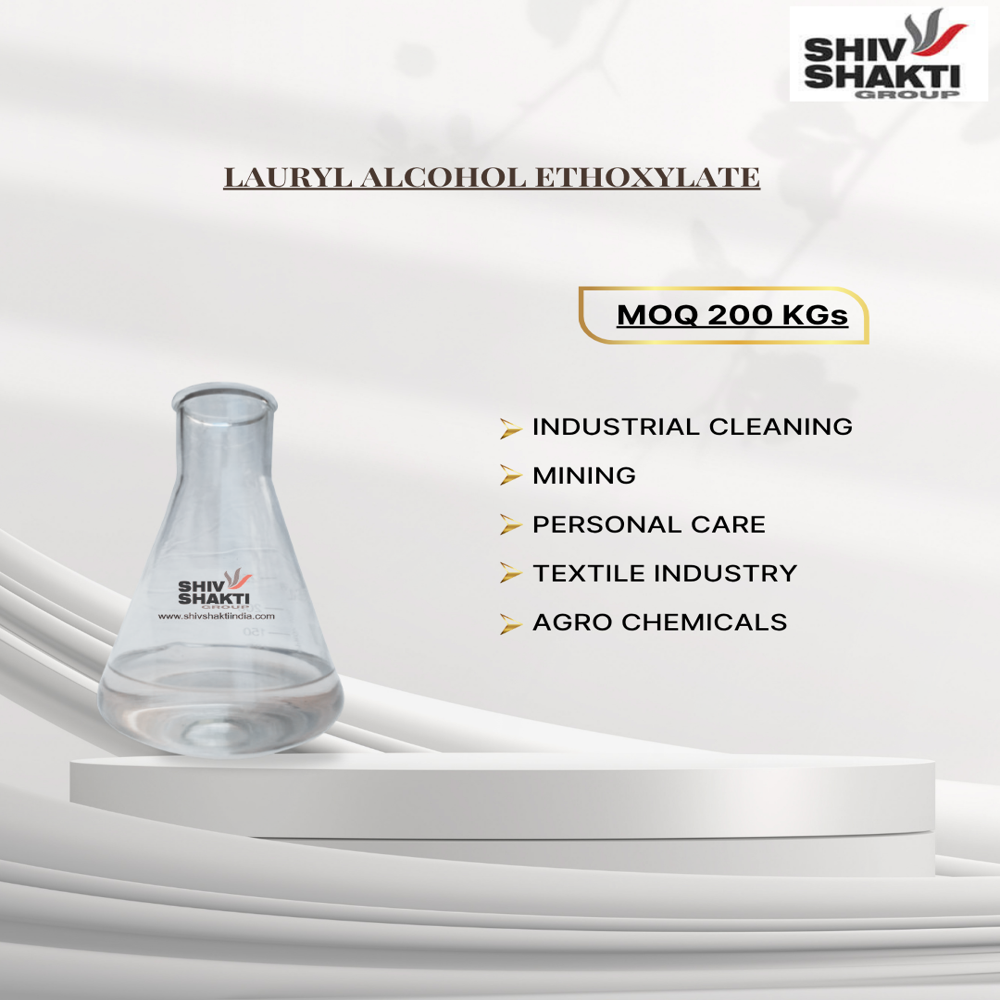


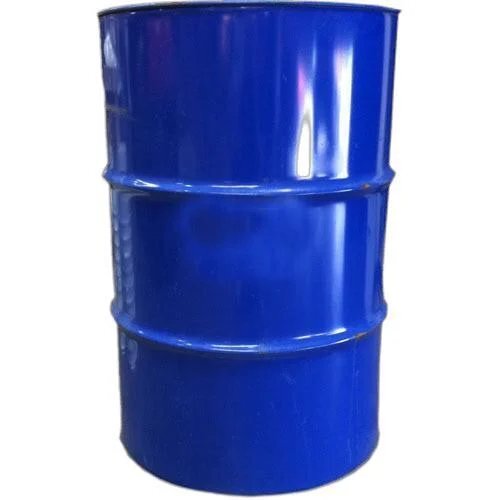
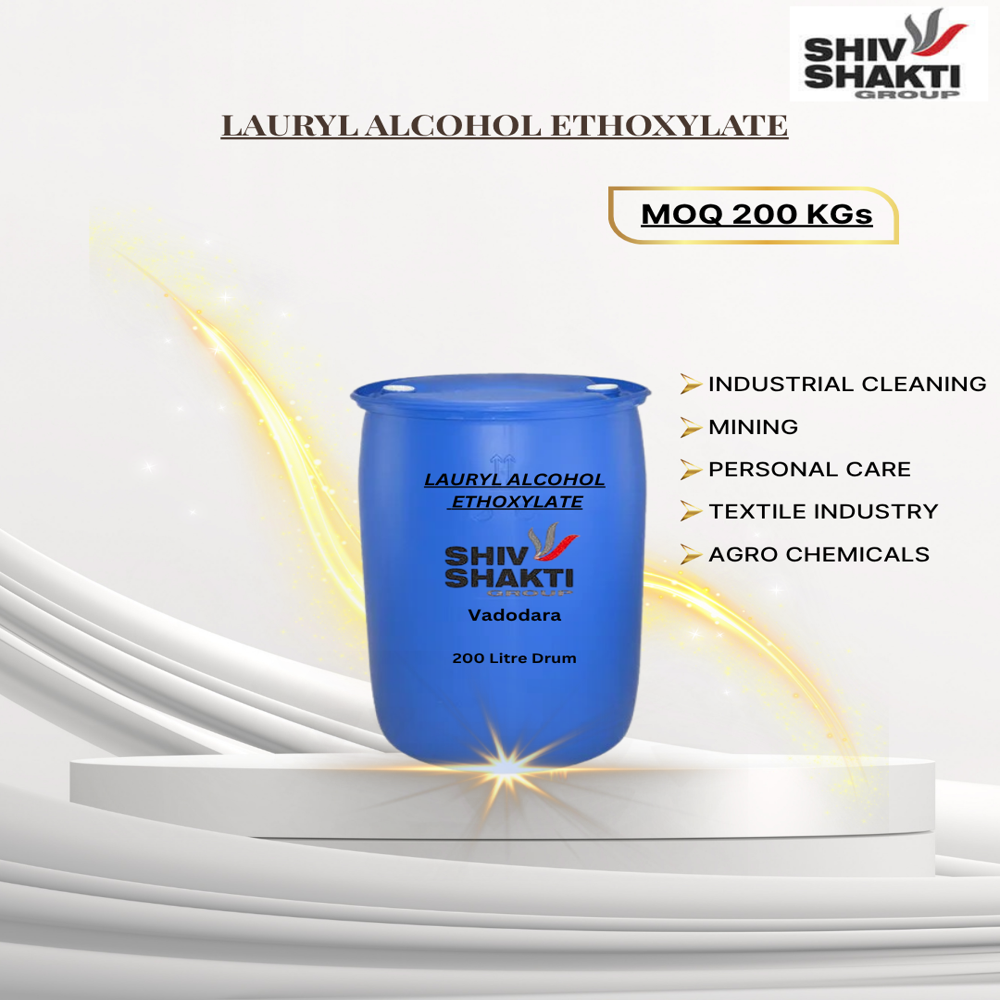
Price 240.0 INR/ Kilograms
- Minimum Order Quantity
- 200 Kilograms
- Supply Ability
- 25000 Kilograms Per Month
- Delivery Time
- 5 Days
- Main Domestic Market
- North India, East India, Gujarat, Karnataka, Jharkhand, Odisha, Punjab, Assam, Delhi, Dadra and Nagar Haveli, Andaman and Nicobar Islands, Arunachal Pradesh, Chhattisgarh, Haryana, Himachal Pradesh, Jammu and Kashmir, Madhya Pradesh, Kerala, Lakshadweep, Mizoram, Meghalaya, Manipur, Andhra Pradesh, Bihar, All India, South India, Central India, West India, Chandigarh, Daman and Diu, Goa, Maharashtra, Nagaland, Rajasthan, Sikkim, Tamil Nadu, Telangana, Tripura, Pondicherry, Uttar Pradesh, Uttarakhand, West Bengal
- Main Export Market(s)
- Asia, Australia, Central America, North America, South America, Eastern Europe, Western Europe, Middle East, Africa

Price:
- 50
- 100
- 200
- 250
- 500
- 1000+
More Products in Disinfectant Chemicals Category
High Boiling Tar Acid (HBTA)
Price 85.0 INR / Kilograms
Minimum Order Quantity : 50 Kilograms
Solubility : most organic solvent
Shelf Life : 2 Years
Density : 1.03 Gram per cubic centimeter(g/cm3)
Poisonous : YES
Cetyl Trimethyl Ammonium Chloride
Price 180.0 INR / Kilograms
Minimum Order Quantity : 50 Kilograms
Solubility : water
Shelf Life : 12 Months
Density : 0.98 1.00 Gram per cubic centimeter(g/cm3)
Poisonous : NO
Cresylic Acid
Price 170 INR / Kilograms
Minimum Order Quantity : 200 Kilograms
Solubility : all most major organic solvents
Shelf Life : 13 Years
Density : 1.03 ~ 1.1 Kilogram per cubic meter (kg/m3)
Poisonous : YES
Chloro Cresol
Price 1000.0 INR
Minimum Order Quantity : 25
Solubility : Slightly Soluble In Water
Shelf Life : 3 Years
Density : 1.15 ~ 1.20 Gram per cubic centimeter(g/cm3)
Poisonous : YES



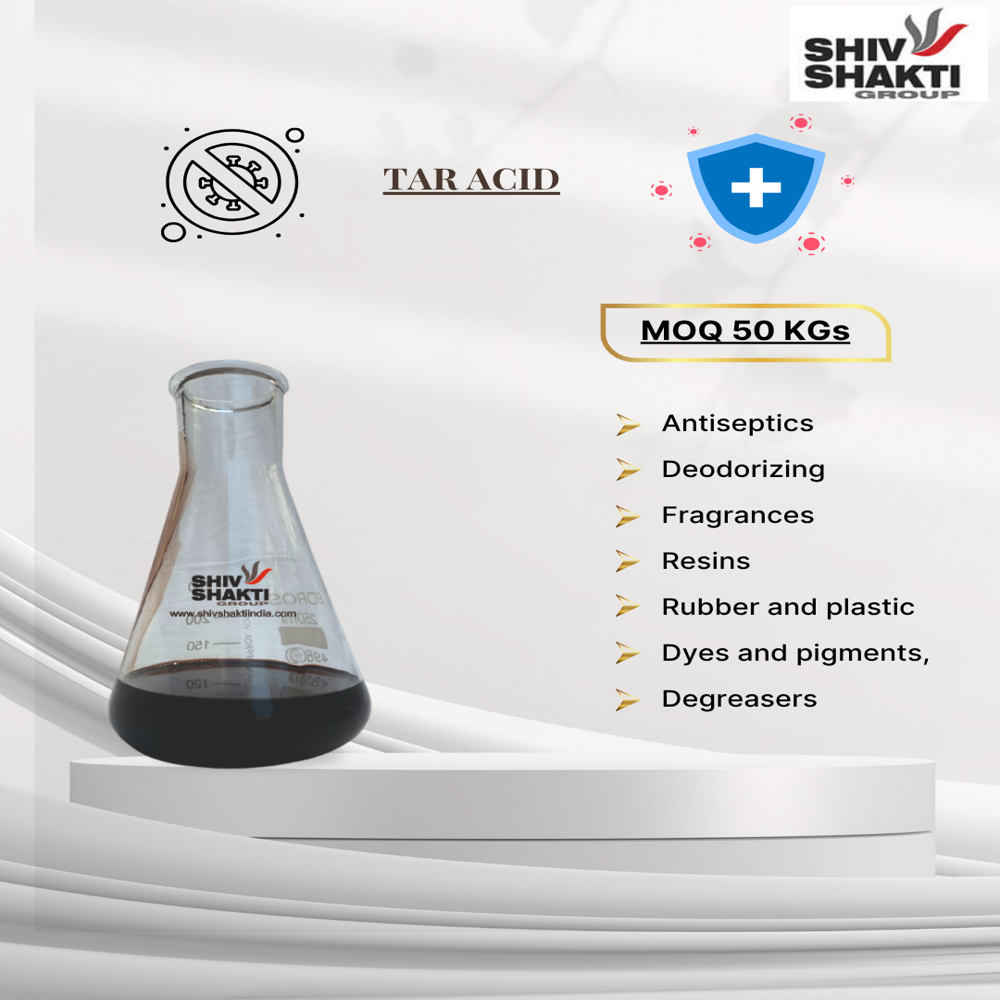
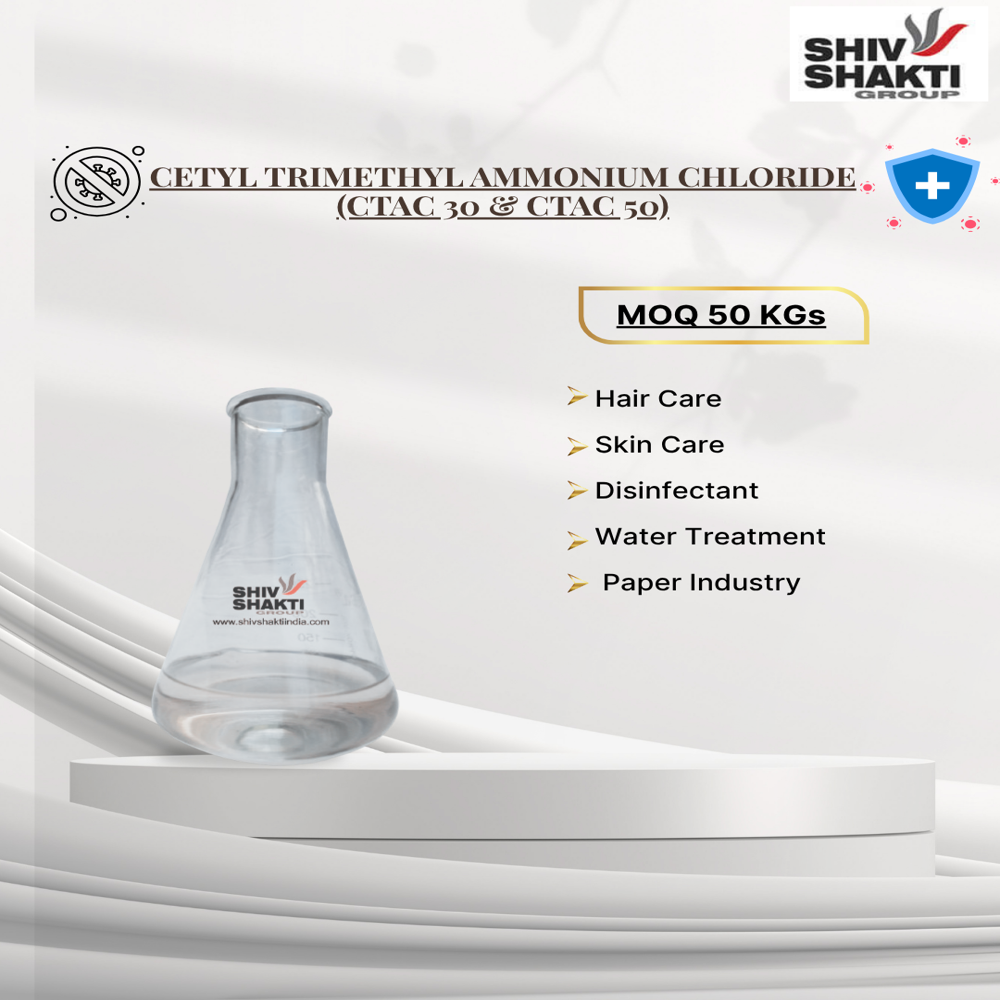



 English
English Spanish
Spanish French
French German
German Italian
Italian Chinese (Simplified)
Chinese (Simplified) Japanese
Japanese Korean
Korean Arabic
Arabic Portuguese
Portuguese